Xianfu Cheng
P2P: Automated Paper-to-Poster Generation and Fine-Grained Benchmark
May 21, 2025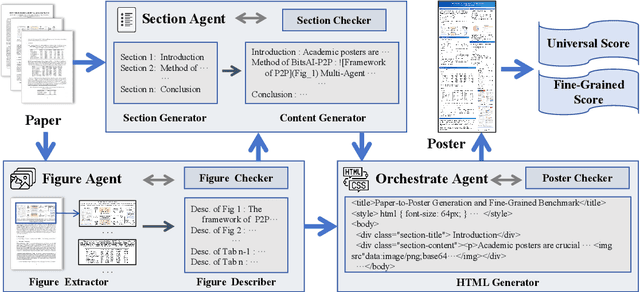
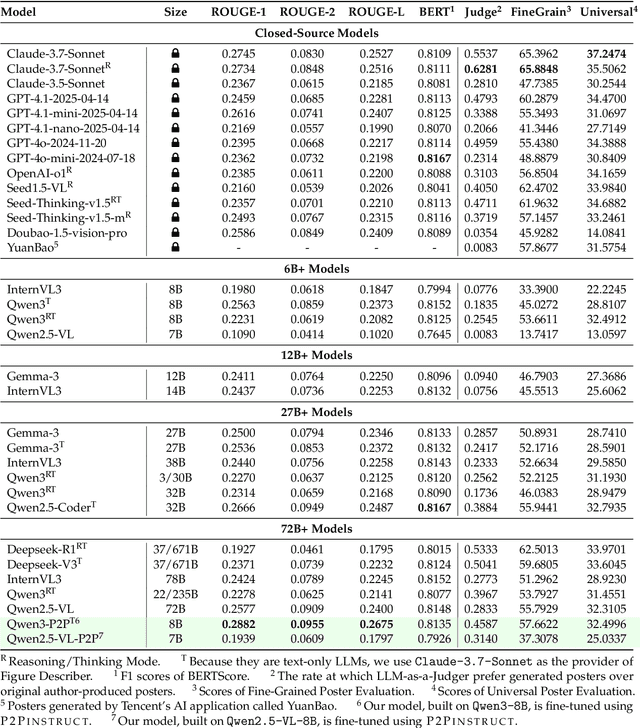
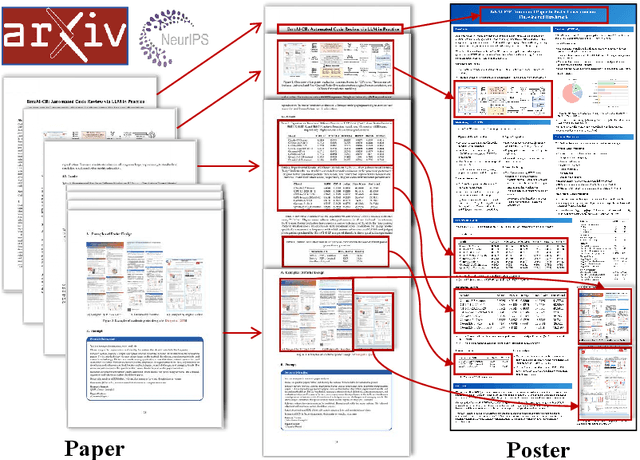

Abstract:Academic posters are vital for scholarly communication, yet their manual creation is time-consuming. However, automated academic poster generation faces significant challenges in preserving intricate scientific details and achieving effective visual-textual integration. Existing approaches often struggle with semantic richness and structural nuances, and lack standardized benchmarks for evaluating generated academic posters comprehensively. To address these limitations, we introduce P2P, the first flexible, LLM-based multi-agent framework that generates high-quality, HTML-rendered academic posters directly from research papers, demonstrating strong potential for practical applications. P2P employs three specialized agents-for visual element processing, content generation, and final poster assembly-each integrated with dedicated checker modules to enable iterative refinement and ensure output quality. To foster advancements and rigorous evaluation in this domain, we construct and release P2PInstruct, the first large-scale instruction dataset comprising over 30,000 high-quality examples tailored for the academic paper-to-poster generation task. Furthermore, we establish P2PEval, a comprehensive benchmark featuring 121 paper-poster pairs and a dual evaluation methodology (Universal and Fine-Grained) that leverages LLM-as-a-Judge and detailed, human-annotated checklists. Our contributions aim to streamline research dissemination and provide the community with robust tools for developing and evaluating next-generation poster generation systems.
What are they talking about? Benchmarking Large Language Models for Knowledge-Grounded Discussion Summarization
May 18, 2025Abstract:In this work, we investigate the performance of LLMs on a new task that requires combining discussion with background knowledge for summarization. This aims to address the limitation of outside observer confusion in existing dialogue summarization systems due to their reliance solely on discussion information. To achieve this, we model the task output as background and opinion summaries and define two standardized summarization patterns. To support assessment, we introduce the first benchmark comprising high-quality samples consistently annotated by human experts and propose a novel hierarchical evaluation framework with fine-grained, interpretable metrics. We evaluate 12 LLMs under structured-prompt and self-reflection paradigms. Our findings reveal: (1) LLMs struggle with background summary retrieval, generation, and opinion summary integration. (2) Even top LLMs achieve less than 69% average performance across both patterns. (3) Current LLMs lack adequate self-evaluation and self-correction capabilities for this task.
SimpleVQA: Multimodal Factuality Evaluation for Multimodal Large Language Models
Feb 18, 2025Abstract:The increasing application of multi-modal large language models (MLLMs) across various sectors have spotlighted the essence of their output reliability and accuracy, particularly their ability to produce content grounded in factual information (e.g. common and domain-specific knowledge). In this work, we introduce SimpleVQA, the first comprehensive multi-modal benchmark to evaluate the factuality ability of MLLMs to answer natural language short questions. SimpleVQA is characterized by six key features: it covers multiple tasks and multiple scenarios, ensures high quality and challenging queries, maintains static and timeless reference answers, and is straightforward to evaluate. Our approach involves categorizing visual question-answering items into 9 different tasks around objective events or common knowledge and situating these within 9 topics. Rigorous quality control processes are implemented to guarantee high-quality, concise, and clear answers, facilitating evaluation with minimal variance via an LLM-as-a-judge scoring system. Using SimpleVQA, we perform a comprehensive assessment of leading 18 MLLMs and 8 text-only LLMs, delving into their image comprehension and text generation abilities by identifying and analyzing error cases.
TableBench: A Comprehensive and Complex Benchmark for Table Question Answering
Aug 17, 2024Abstract:Recent advancements in Large Language Models (LLMs) have markedly enhanced the interpretation and processing of tabular data, introducing previously unimaginable capabilities. Despite these achievements, LLMs still encounter significant challenges when applied in industrial scenarios, particularly due to the increased complexity of reasoning required with real-world tabular data, underscoring a notable disparity between academic benchmarks and practical applications. To address this discrepancy, we conduct a detailed investigation into the application of tabular data in industrial scenarios and propose a comprehensive and complex benchmark TableBench, including 18 fields within four major categories of table question answering (TableQA) capabilities. Furthermore, we introduce TableLLM, trained on our meticulously constructed training set TableInstruct, achieving comparable performance with GPT-3.5. Massive experiments conducted on TableBench indicate that both open-source and proprietary LLMs still have significant room for improvement to meet real-world demands, where the most advanced model, GPT-4, achieves only a modest score compared to humans.
XFormParser: A Simple and Effective Multimodal Multilingual Semi-structured Form Parser
May 27, 2024Abstract:In the domain of document AI, semi-structured form parsing plays a crucial role. This task leverages techniques from key information extraction (KIE), dealing with inputs that range from plain text to intricate modal data comprising images and structural layouts. The advent of pre-trained multimodal models has driven the extraction of key information from form documents in different formats such as PDFs and images. Nonetheless, the endeavor of form parsing is still encumbered by notable challenges like subpar capabilities in multi-lingual parsing and diminished recall in contexts rich in text and visuals. In this work, we introduce a simple but effective \textbf{M}ultimodal and \textbf{M}ultilingual semi-structured \textbf{FORM} \textbf{PARSER} (\textbf{XFormParser}), which is anchored on a comprehensive pre-trained language model and innovatively amalgamates semantic entity recognition (SER) and relation extraction (RE) into a unified framework, enhanced by a novel staged warm-up training approach that employs soft labels to significantly refine form parsing accuracy without amplifying inference overhead. Furthermore, we have developed a groundbreaking benchmark dataset, named InDFormBench, catering specifically to the parsing requirements of multilingual forms in various industrial contexts. Through rigorous testing on established multilingual benchmarks and InDFormBench, XFormParser has demonstrated its unparalleled efficacy, notably surpassing the state-of-the-art (SOTA) models in RE tasks within language-specific setups by achieving an F1 score improvement of up to 1.79\%. Our framework exhibits exceptionally improved performance across tasks in both multi-language and zero-shot contexts when compared to existing SOTA benchmarks. The code is publicly available at https://github.com/zhbuaa0/layoutlmft.
ECLIPSE: Semantic Entropy-LCS for Cross-Lingual Industrial Log Parsing
May 22, 2024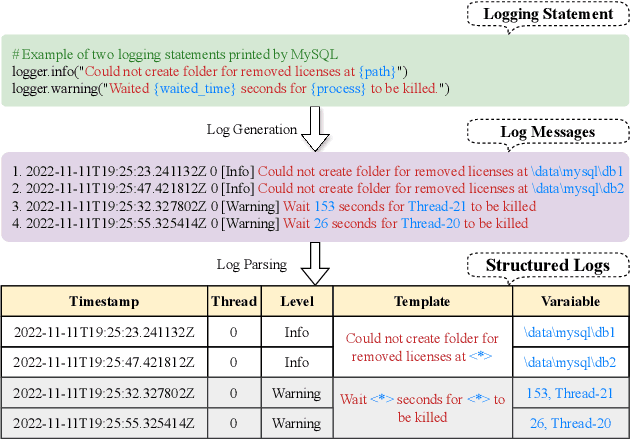
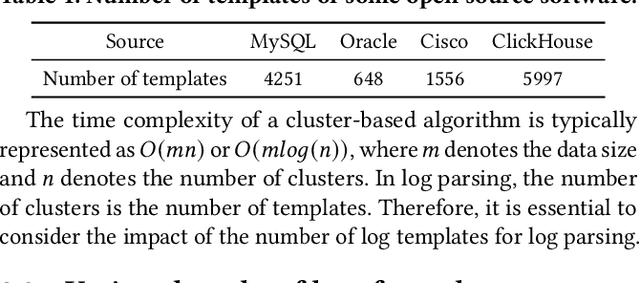
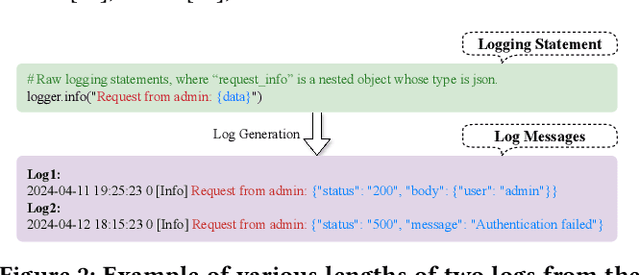
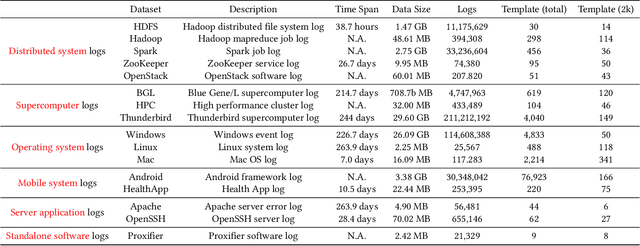
Abstract:Log parsing, a vital task for interpreting the vast and complex data produced within software architectures faces significant challenges in the transition from academic benchmarks to the industrial domain. Existing log parsers, while highly effective on standardized public datasets, struggle to maintain performance and efficiency when confronted with the sheer scale and diversity of real-world industrial logs. These challenges are two-fold: 1) massive log templates: The performance and efficiency of most existing parsers will be significantly reduced when logs of growing quantities and different lengths; 2) Complex and changeable semantics: Traditional template-matching algorithms cannot accurately match the log templates of complicated industrial logs because they cannot utilize cross-language logs with similar semantics. To address these issues, we propose ECLIPSE, Enhanced Cross-Lingual Industrial log Parsing with Semantic Entropy-LCS, since cross-language logs can robustly parse industrial logs. On the one hand, it integrates two efficient data-driven template-matching algorithms and Faiss indexing. On the other hand, driven by the powerful semantic understanding ability of the Large Language Model (LLM), the semantics of log keywords were accurately extracted, and the retrieval space was effectively reduced. It is worth noting that we launched a Chinese and English cross-platform industrial log parsing benchmark ECLIPSE-Bench to evaluate the performance of mainstream parsers in industrial scenarios. Our experimental results, conducted across public benchmarks and the proprietary ECLIPSE-Bench dataset, underscore the superior performance and robustness of our proposed ECLIPSE. Notably, ECLIPSE delivers state-of-the-art performance when compared to strong baselines on diverse datasets and preserves a significant edge in processing efficiency.
VIPTR: A Vision Permutable Extractor for Fast and Efficient Scene Text Recognition
Jan 24, 2024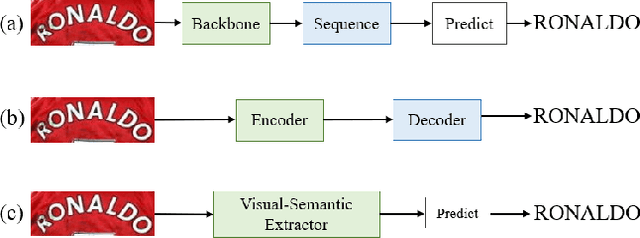
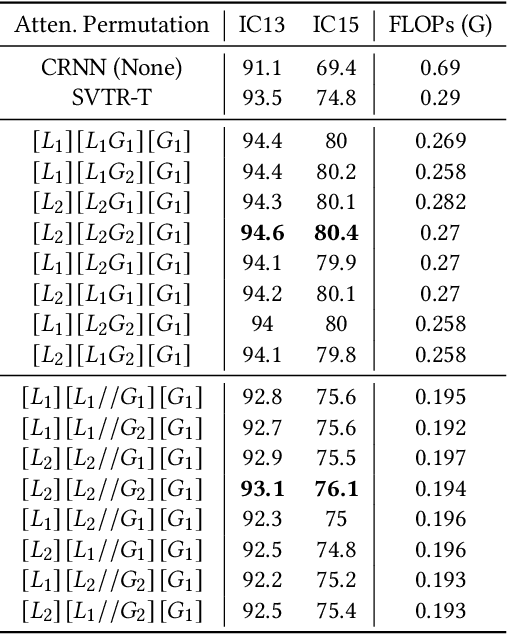
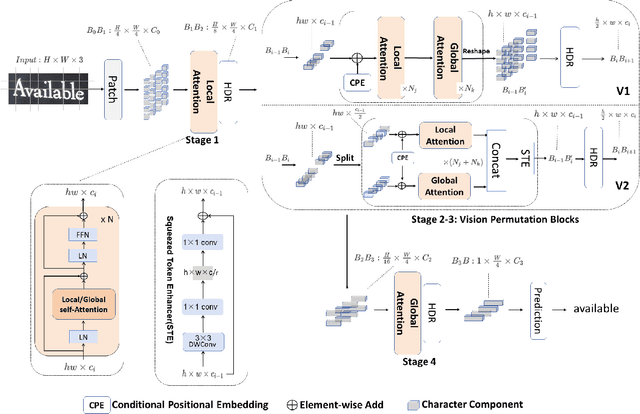
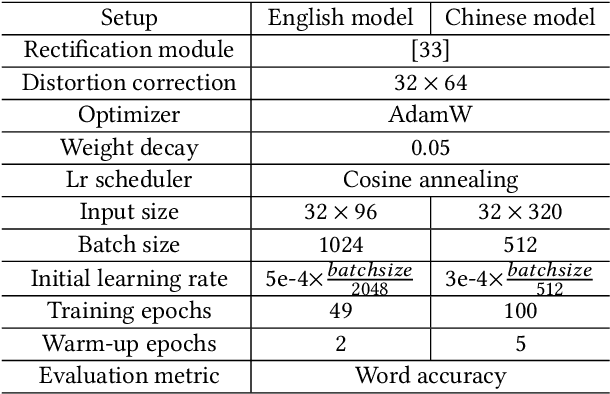
Abstract:Scene Text Recognition (STR) is a challenging task that involves recognizing text within images of natural scenes. Although current state-of-the-art models for STR exhibit high performance, they typically suffer from low inference efficiency due to their reliance on hybrid architectures comprised of visual encoders and sequence decoders. In this work, we propose the VIsion Permutable extractor for fast and efficient scene Text Recognition (VIPTR), which achieves an impressive balance between high performance and rapid inference speeds in the domain of STR. Specifically, VIPTR leverages a visual-semantic extractor with a pyramid structure, characterized by multiple self-attention layers, while eschewing the traditional sequence decoder. This design choice results in a lightweight and efficient model capable of handling inputs of varying sizes. Extensive experimental results on various standard datasets for both Chinese and English scene text recognition validate the superiority of VIPTR. Notably, the VIPTR-T (Tiny) variant delivers highly competitive accuracy on par with other lightweight models and achieves SOTA inference speeds. Meanwhile, the VIPTR-L (Large) variant attains greater recognition accuracy, while maintaining a low parameter count and favorable inference speed. Our proposed method provides a compelling solution for the STR challenge, which blends high accuracy with efficiency and greatly benefits real-world applications requiring fast and reliable text recognition. The code is publicly available at https://github.com/cxfyxl/VIPTR.
Multi-Stage Pre-training Enhanced by ChatGPT for Multi-Scenario Multi-Domain Dialogue Summarization
Oct 16, 2023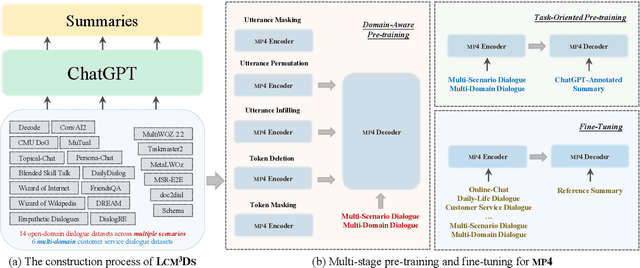


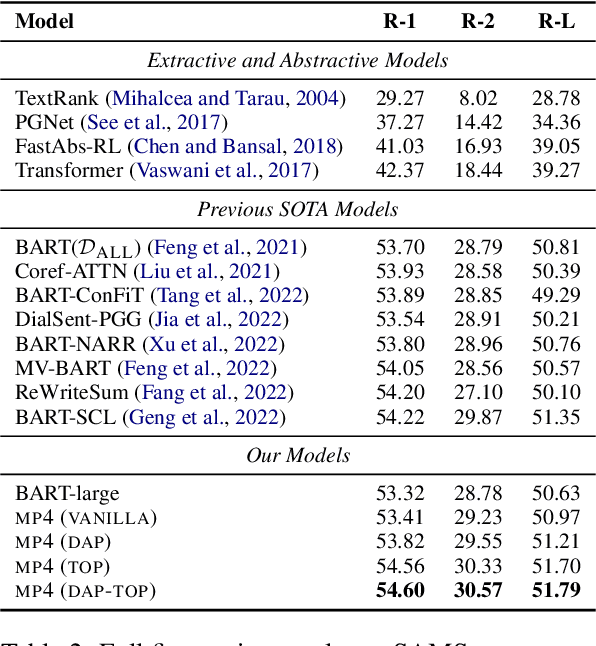
Abstract:Dialogue summarization involves a wide range of scenarios and domains. However, existing methods generally only apply to specific scenarios or domains. In this study, we propose a new pre-trained model specifically designed for multi-scenario multi-domain dialogue summarization. It adopts a multi-stage pre-training strategy to reduce the gap between the pre-training objective and fine-tuning objective. Specifically, we first conduct domain-aware pre-training using large-scale multi-scenario multi-domain dialogue data to enhance the adaptability of our pre-trained model. Then, we conduct task-oriented pre-training using large-scale multi-scenario multi-domain "dialogue-summary" parallel data annotated by ChatGPT to enhance the dialogue summarization ability of our pre-trained model. Experimental results on three dialogue summarization datasets from different scenarios and domains indicate that our pre-trained model significantly outperforms previous state-of-the-art models in full fine-tuning, zero-shot, and few-shot settings.
 Add to Chrome
Add to Chrome Add to Firefox
Add to Firefox Add to Edge
Add to Edge